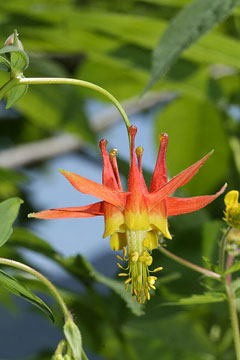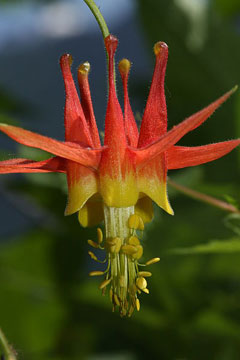 |
|
http://commons.wikimedia.org/wiki/User:Wsiegmund |
 |
| http://commons.wikimedia.org/wiki/User:Wsiegmund |
Translate this page:
Summary
Western columbine is another widespread and highly ornamental species found in western North America, typically growing along streams, moist slopes, and forest openings. It grows 40–90 cm tall, sometimes exceeding a meter in height, and produces nodding red-and-yellow flowers with long spurs, which bloom from spring into midsummer. As with other columbines, only the flowers are reported to be edible, but their flavor is considered poor. Crimson columbine flowers have a brief sweetness from nectar, quickly overtaken by strong, medicine-like overtones. Like all Aquilegia species, the foliage, roots, and seeds are toxic due to the presence of alkaloids and cyanogenic glycosides, and ingestion can cause severe illness. Despite its low food value, western columbine is ecologically important. The flowers are adapted for pollination by hummingbirds, whose long beaks and tongues reach the nectar in the spurs. Bumblebees and other long-tongued insects may also contribute. Its seeds are dispersed locally, and plants often establish along riparian zones, where they help stabilize soils. It prefers moist, humus-rich soils in partial shade but tolerates sun in cool, wet environments. It is common at low to mid elevations throughout the Pacific Northwest and into the Rockies.
Physical Characteristics

 Aquilegia formosa is a PERENNIAL growing to 0.8 m (2ft 7in) by 0.5 m (1ft 8in).
Aquilegia formosa is a PERENNIAL growing to 0.8 m (2ft 7in) by 0.5 m (1ft 8in).
See above for USDA hardiness. It is hardy to UK zone 3. It is in flower from May to August, and the seeds ripen from July to September. The species is hermaphrodite (has both male and female organs) and is pollinated by Bees.
Suitable for: light (sandy) and medium (loamy) soils and prefers well-drained soil. Suitable pH: mildly acid, neutral and basic (mildly alkaline) soils. It can grow in semi-shade (light woodland) or no shade. It prefers moist soil.
UK Hardiness Map
US Hardiness Map
Synonyms
Plant Habitats
Woodland Garden Dappled Shade; Shady Edge;
Edible Uses
Edible Parts: Flowers Leaves Root
Edible Uses:
As with other columbines, only the flowers are reported edible, but their flavor is poor. Crimson columbine flowers have brief sweetness from nectar quickly overtaken by strong medicine-like overtones. Like all Aquilegia species, the foliage, roots, and seeds are toxic due to alkaloids and cyanogenic glycosides, and ingestion can cause severe illness [2-3]. Flowers - raw. Rich in nectar, they are sweet and delightful[172, 213], they make a very attractive addition to mixed salads and can also be used as a thirst-quenching munch in the garden[K]. Children enjoy sucking out the sweet nectar from the base of the flowers[257]. Early spring greens cooked and eaten as a vegetable[257]. Some caution is advised, see the notes above on toxicity. Root - cooked. Used by the N. American Indians as a famine food[213]. Some caution is advised, see the notes above on toxicity.
References More on Edible Uses
Medicinal Uses
Plants For A Future can not take any responsibility for any adverse effects from the use of plants. Always seek advice from a professional before using a plant medicinally.
Antispasmodic Diaphoretic Parasiticide Parasiticide Resolvent Salve
Western columbine was quite frequently employed by a number of native North American Indian tribes who used it to treat a variety of complaints[257]. It is little used in modern herbalism. Antispasmodic, diaphoretic, parasiticide, resolvent, salve[172]. A decoction of the root is used in the treatment of diarrhoea and stomach aches[257]. A decoction of the roots and leaves is used in the treatment of VD, dizziness and biliousness[257]. The mashed fresh roots can be rubbed briskly on aching rheumatic joints[257]. A poultice of chewed roots or leaves is applied to bee stings, sores etc[257]. A decoction of the leaves is used in the treatment of sore throats, coughs and colds[257]. The seeds can be chewed as a remedy for stomach aches[257].
References More on Medicinal Uses
The Bookshop: Edible Plant Books
Our Latest books on Perennial Plants For Food Forests and Permaculture Gardens in paperback or digital formats.

Edible Tropical Plants
Food Forest Plants for Hotter Conditions: 250+ Plants For Tropical Food Forests & Permaculture Gardens.
More

Edible Temperate Plants
Plants for Your Food Forest: 500 Plants for Temperate Food Forests & Permaculture Gardens.
More

More Books
PFAF have eight books available in paperback and digital formats. Browse the shop for more information.
Shop Now
Other Uses
Hair Parasiticide Parasiticide
The seed is used to rid the hair of lice[172, 257]. The whole plant is boiled up and used as a hair wash[213, 257]. The seeds are aromatic. They can be crushed and rubbed on the body as a perfume or placed in a sachet and stored with clothes to impart a nice smell[257].
Special Uses
References More on Other Uses
Cultivation details
Succeeds in ordinary garden soil, preferring a moist but not wet soil and a sheltered sunny position[1] or partial shade[187]. Intolerant of heavy clay[200]. A very ornamental plant, it is hardy to about -15°c[187]. A short-lived species, often dying out after 2 - 3 years, though it usually produces seed prolifically[200, 233]. However, they are very apt to hybridize with other members of the genus and so it becomes difficult to keep a species true to type if more than one is grown in the garden[200]. This species is closely related to A. canadensis[200] and A. flavescens[60], often hybridizing with A. flavescens in the wild where their ranges overlap[270]. Plants seem to be immune to the predations of rabbits[233]. A greedy plant, inhibiting the growth of nearby plants, especially legumes[54].
References Carbon Farming Information and Carbon Sequestration Information
Temperature Converter
Type a value in the Celsius field to convert the value to Fahrenheit:
Fahrenheit:
The PFAF Bookshop
Plants For A Future have a number of books available in paperback and digital form. Book titles include Edible Plants, Edible Perennials, Edible Trees,Edible Shrubs, Woodland Gardening, and Temperate Food Forest Plants. Our new book is Food Forest Plants For Hotter Conditions (Tropical and Sub-Tropical).
Shop Now
Plant Propagation
Seed - best sown as soon as it is ripe in a cold frame. The seed can be slow to germinate[200]. Stored seed can be sown in late winter in a cold frame. When large enough to handle, prick the seedlings out into individual pots and grow them on in a cold frame for their first winter. Plant out in late spring or early summer. Division in spring[200].
Other Names
If available other names are mentioned here
Native Range
NORTHERN AMERICA: Canada (Yukon (south), Alberta (southwest), British Columbia), United States (Alaska (south), Idaho, Montana (west), Oregon, Washington, California, Nevada, Utah), Mexico (Baja California (Norte))
Weed Potential
Right plant wrong place. We are currently updating this section.
Please note that a plant may be invasive in one area but may not in your area so it's worth checking.
This is a native, non-invasive wildflower with ecological rather than agricultural importance.
Conservation Status
IUCN Red List of Threatened Plants Status :

| Related Plants
|
| Latin Name | Common Name | Habit | Height | Hardiness | Growth | Soil | Shade | Moisture | Edible | Medicinal | Other |
| Aquilegia brevistyla | Smallflower columbine | Perennial | 0.9 |
0-0
| | LM | SN | M | 2 | 1 | 1 |
| Aquilegia buergeriana | | Perennial | 0.6 |
6-9
| | LMH | SN | M | 2 | 0 | 1 |
| Aquilegia canadensis | Wild Columbine, Red columbine, Meeting Houses, Common Columbine | Perennial | 0.6 |
4-10
| M | LM | SN | M | 2 | 2 | 2 |
| Aquilegia coerulea | Rocky Mountain Columbine | Perennial | 0.6 |
3-7
| S | LM | SN | M | 2 | 1 | 1 |
| Aquilegia flabellata | Fan Columbine, Dwarf Columbine | Perennial | 0.3 |
3-9
| S | LM | SN | M | 2 | 0 | 1 |
| Aquilegia flavescens | Columbine, Yellow columbine | Perennial | 0.8 |
4-8
| | LM | SN | M | 2 | 1 | 1 |
| Aquilegia formosa truncata | Columbine | Perennial | 0.9 |
3-7
| | LM | SN | M | 2 | 2 | 1 |
| Aquilegia jonesii | Columbine, Jones' columbine, Blue limestone columbine | Perennial | 0.1 |
3-7
| | LM | SN | M | 2 | 1 | 1 |
| Aquilegia karelinii | | Perennial | 0.8 |
-
| | LM | SN | M | 2 | 0 | 1 |
| Aquilegia pubescens | Columbine, Sierra columbine | Perennial | 0.5 |
4-8
| | LM | SN | M | 2 | 1 | 1 |
| Aquilegia shockleyi | | Perennial | 0.8 |
6-9
| | LM | SN | M | 2 | 1 | 1 |
| Aquilegia vulgaris | Columbine, European columbine, Granny's Bonnet, European Crowfoot | Perennial | 1.0 |
3-9
| M | LM | SN | M | 2 | 1 | 1 |
| Semiaquilegia adoxoides | Tian Kui | Perennial | 0.3 |
5-9
| | LMH | SN | M | 0 | 2 | |
|
Growth: S = slow M = medium F = fast. Soil: L = light (sandy) M = medium H = heavy (clay). pH: A = acid N = neutral B = basic (alkaline). Shade: F = full shade S = semi-shade N = no shade. Moisture: D = dry M = Moist We = wet Wa = water.
Now available:
Food Forest Plants for Mediterranean Conditions
350+ Perennial Plants For Mediterranean and Drier Food Forests and Permaculture Gardens.
[Paperback and eBook]
This is the third in Plants For A Future's series of plant guides for food forests tailored to
specific climate zones. Following volumes on temperate and tropical ecosystems, this book focuses
on species suited to Mediterranean conditions—regions with hot, dry summers and cool, wet winters,
often facing the added challenge of climate change.
Read More
Expert comment
Author
Fisch.
Botanical References
60200270
Links / References
For a list of references used on this page please go here
Readers comment
| Add a comment |
|
If you have important information about this plant that may help other users please add a comment or link below. Only comments or links that are felt to be directly relevant to a plant will be included. If you think a comment/link or information contained on this page is inaccurate or misleading we would welcome your feedback at [email protected]. If you have questions about a plant please use the Forum on this website as we do not have the resources to answer questions ourselves.
* Please note: the comments by website users are not necessarily those held by PFAF and may give misleading or inaccurate information.
To leave a comment please Register or login here All comments need to be approved so will not appear immediately.
|
Subject : Aquilegia formosa
|
|
|
|